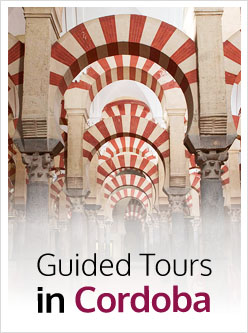Royal Collegiate Church of San Hipólito
Monarch Alfonso XI promised, during the Battle of the Salado, that, if we was victorious, he would erect a Collegiate Church in honour of San Hipólito, as he had been born on that day, 13th August 1311. Ramírez de las Casas Deza tells that the church was commissioned through a royal document granted in Alcalá de Henares on 25th January 1348. A year earlier, Pope Clemente VI had granted the Monarch free power to appoint a Prior and nine canons, who would be in charge of the collegiate church.
Only the apse and the arms of the transept are preserved of the Collegiate Church of San Hipólito erected by Alfonso XI. A great pointed arch supports the transept and leads to the apse of the church, which consists of a polygonal floor covered by a Gothic ribbed vault, made of ribs decorated with saw teeth, starting from Gothic capitals with leaves and a central rib. On the walls we can see fine and elegant geminated openings covered by pointed arches.
The works in the new church started in 1729, led by architect Juan de Aguilar. He designed a Latin cross shape with only one nave, as wide as the apse, and covered by a barrel vault with lunettes. The façade has a diminished round arch, whose spandrels are decorated with geommetrical motifs, as well as the pilasters flanking them. A second section has a parted circular pediment as a base, where we can highlight a stone image of the saint after which the church is named inside an alcove. The rest of the façade, with a triangular pediment at its top, is decorated with fine and elegant decorative plaques, which were very typical of Córdoba at that time, and which started the style so-called Baroque of plaques from Córdoba.
In 1773 the Canonry of the Collegiate Church of San Hipólito decided to demolish the old tower and erect a new one on its base. The master chosen for it was Pedro de Lara, who designed an excellent tower with four sections, of which only two were built, as we can see nowadays. The first of them is a 15-metre high rectangular prism, where the only decoration consists of small empty frames inside, or the corbels supporting the cornice that leads to the second section. This has three plain pilasters with Tuscan capital on each side, and between them we can see two round openings, that is, eight openings for eigh bells. Over the pilasters we can see an entablature with triglyphs and plain metope, holding the cornice at the top of the ensemble.
When King Fernando IV died in Jaén in 1312, they decided to bury him in Córdoba, as the high temperatures made it difficult to guarantee a transfer to Seville or Toledo, the capital. Years later, more specifically in 1350, his son Alfonso XI died, founder of the Collegiate Church, while Gibraltar was being besieged due to the plague. His remains were taken to the Royal Chapel of Seville, where they stayed until they were transfered to Córdoba in 1371, when the works in the Royal Chapel of the Cathedral of Córdoba were finished; thus the remains of both monarchs were placed there.
At the beginning of the 18th century, the canons of the Collegiate Church of San Hipólito requested King Felipe V that the foundations of the Collegiate Church and the Royal Chapel should be united, in order for the remains of the kings to be taken there, according to Alfonso XI’s will. Felipe V accepted the canons’ request and asked for the necessary permissions from Pope Benedict XIII, and the bodies were transfered on 8th August 1736.
For more than a century the kings remained in the presbytery of the church inside simple wooden coffins, where they were shown to visitors. The Committee of Monuments made the current red marble sepulchres in 1846. On the side of the Gospel there is Alfonso XI’s sepulchre, whereas on the side of the Epistle, we can see the one belonging to Fernando IV.
If you are wondering what to do in Córdoba, we recommend you visit the Collegiate Church of San Hipólito hiring one of our guided tours. Choose to do high quality sightseeing with qualified staff. Do not hesitate, ArtenCórdoba is the best option.
Text: J.A.S.C.


All the information about the monuments, festivals and places of interest in Cordoba... at a click!
If you want more information about the monuments of Cordoba, before doing your guided tours, here is the most complete guide, written by the tour guides and historians of our team
Over 2,000 items!
Mosque-Cathedral
Medina Azahara
Alcazar of the Christian Kings
Synagogue
The Museums
The Coutyards

All the information about the monuments, festivals and places of interest in Cordoba... at a click!
If you want more information about the monuments of Cordoba, before doing your guided tours, here is the most complete guide, written by the tour guides and historians of our team
Over 2,000 items!





















